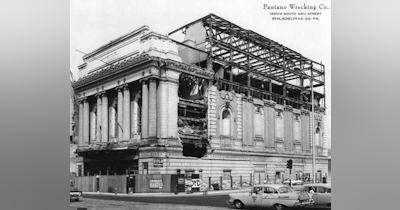The ad in the Philadelphia newspapers for Hitchy-Koo, an Intimate Revue - December 1917. Raymond Hitchcock is shown playing a tuba in a sketch from the show.
Here are images of events and people that we talk about in Episode 65, "Holiday Show - 2023."
Below left, the subsequent notice placed by the Shuberts, telling Philadelphia that the Christmas Eve performance at the Lyric Theatre (right) was canceled, due to transportation issues.
Two of the female members of the Hitchy-Koo company. Left, singer Grace La Rue posing with an American flag for the patriotic final number. Right, a member of the "Orchid Chorus."
A 1934 British advertising poster for the D'Oyly Carte company - and a collectible cigarette card featuring comic baritone Martyn Green. (Below that, the ad for the Savoyards that appeared in the Philadelphia Inquirer in December 1934.)
Eartha Kitt and William Marshall in costume for the Philadelphia premiere of Timbuktu! (It's always fun to type that exclamation point on the title!) Below, a photo of Kitt with members of the company - in their startlingly brief attire.
It is relevant to note, perhaps, that the Afrocentric nature of the costume design for the performers was influenced heavily by the those of touring African dance troupes, such as The Dance Theatre of Sierra Leone or Les Ballets Africains - a touring company from Guinea that had toured extensively in the U.S. during the 1960s.
Choreographer Fodeba Keita's 45-member strong company had performed all around the world, but its tours of the US were particularly influential in spreading innovative renditions of traditional African dance and music. It had performed at the Shubert Theatre in Philadelphia as early as February 1959, and at the Locust Theatre in 1960. In 1967, the troupe performed at the Lambertville Music Circus in New Jersey, just north of Philadelphia. A drawing of the troupe appeared in the Inquirer:
The female dancers of Les Ballets Africains were known for appearing onstage topless - and on several occasions the company was denied permission to perform in some cities because of this. (Interestingly, given Philadelphia's history of stage censorship, no restrictions occurred when they came to The Quaker City.)
Below, the full advertisement for El Nino Eddie, from the collection of the Victoria & Albert Museum in London, that we mention in the podcast. I used a detail from this print for the icon image of this episode. (And I almost put a Santa hat on him, too, but then decided not to.)
Here are side-by-side comparisons of two bills featuring El Nino Eddie. Though they are almost three decades apart, the two venues were only a few blocks away from each other in the city. On the left, from December 1864, is for Sanford's Minstrels, which was on Race Street between 2nd and 3rd. On the right, a newspaper ad for the New Years' Day show at the Star Theatre on 8th and Vine.
Notable in the Sanford’s poster is a mention of "The Oil Regions." Minstrel troupes always strove to be topical, and by 1864 the recent discovery and exploitation of petroleum in Western Pennsylvania was on the minds of many Philadelphians. There was wild speculation in oil stocks and companies, even in the midst of the ongoing Civil War.
There are two blackface burlesques of Shakespeare listed on the playbill as well. We can note that both Romeo & Juliet and Richard III were being parodied, with the white male members of the troupe playing all the roles. Characters such as Juliet and Queen Elizabeth were likely done as "negro wenches" - a phenomenon we have discussed in several episodes of our podcast. Again, there was topicality to adding Richard III to the bill of fare in December of 1864, because Edwin Forrest was playing the role at the Academy of Music that same week. Sanford's Minstrels often burlesqued the efforts of “high class” actors, dancers and musicians performing elsewhere in the city.
At any rate, on this particular evening El Nino Eddie was the star of the show!
Three decades later, however, Eddie had slipped far down the bill of the vaudeville offerings at the Star. The headliner was Madame Shirley, "Europe's Comic Opera Queen." Eddie is at the top of a list of acts that don't even merit a special description. Likely he was occupying the opening spot on the bill, which was often given to silent acrobatic acts. It was a slot not much favored by vaudeville performers, because much of the audience was usually still entering the house, taking their seats - and probably talking - for the first fifteen minutes of the show.
Lastly, a photograph of Antonio Van Zandt (Signor Blitz), and the poster of his shows at Langstroth's Hall in Germantown. At the very bottom is a photo of patients in the ward of a Union Army Hospital in Philadelphia.





















